Analysis of the optical elements of an SLR camera

1.- Analysis and calculations of variables in the generation of images in a convergent lens.
2.- Calculations of variables in image generation in a diverging lens.
4.- Converging-converging lens arrangement in the optical system of a refracting telescope.
5.- Geometry implemented in the understanding of the algebraic formulation of thin lenses.
6.- Analysis of the arrangement of the optical system of a Newtonian reflecting telescope.
7.- Analysis of the arrangement of the optical system of a Newtonian reflecting telescope.
8.- Analysis of the optical elements of a Sextant.
9.- Analysis of the optical elements of a Porro binoculars.
10.- Analysis of the optical elements of a periscope.
In our tour through these optical instruments, we have analyzed important devices such as; the refracting and reflecting telescope, the sextant, Porro binoculars and Periscope, this time, we will have the purpose of analyzing in a general way the optical elements of a reflex camera and visualize the generation of images in these optical elements, until they reach our retinas and from there to our brain.
For no one is a secret that nowadays we are all related to photographs, especially by the use of portable digital cameras that have our cell phones, which is why we can constantly capture or freeze certain moments of our lives in a photograph, ie, the photographic cameras have evolved enormously leaving aside (although not entirely) the analogical photographs and, when we refer to the term reflex, it is a term closely linked to the time of the analogical photos, yes, of that time where it was necessary to develop a certain reel or film in order to be able to observe the final result of a photograph.
Now, we find that in the world of photography the word reflex is related to those cameras that implement a plane mirror in its optical system and, this plane mirror, located in the middle of other important optical elements such as lenses (convergent and divergent), where we also find a reflective pentaprism, the plane mirror will reflect the luminous rays coming from the objective part of the instrument, to then send them to the pentaprism located in the part of the ocular or viewfinder of a photographic camera, our task is to analyze in a general way the route of the image in each one of these optical elements until arriving at our retina, for it, it is necessary that they can visualize the following figure 1.
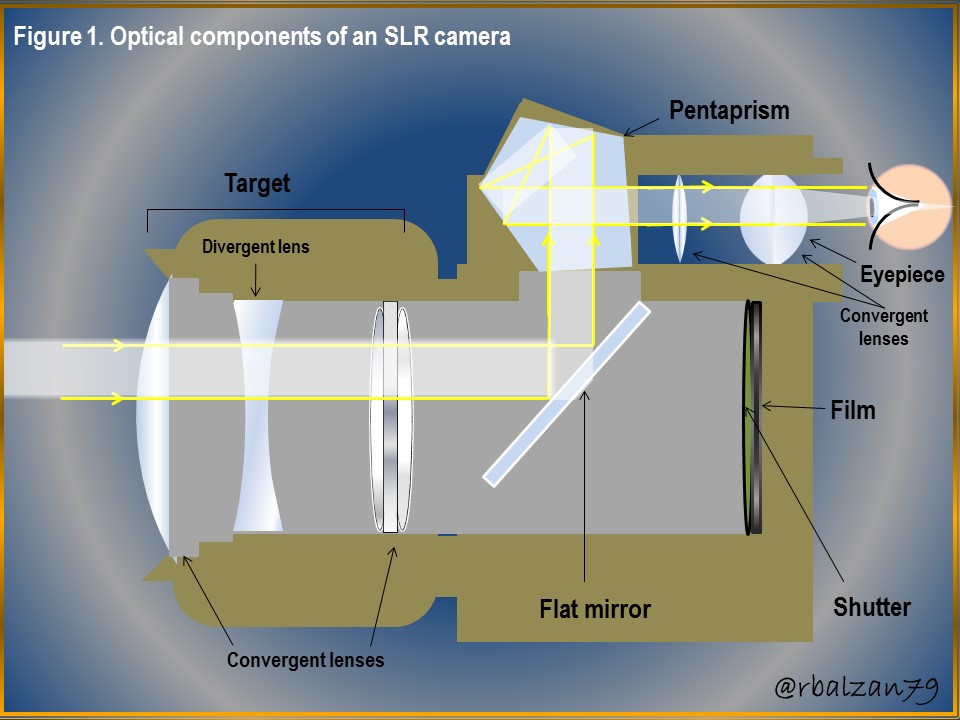
In the previous figure 1, you could notice the optical elements of a reflex camera, these cameras may have many more lenses in its objective part, however, for our analysis with the lenses present in figure 1, it will give us a general sample of the behavior of the images that are generated in each optical element present, therefore, let's start with the generation of the images of the lenses present in the objective part of this optical instrument, as you can see in the following figure 2.
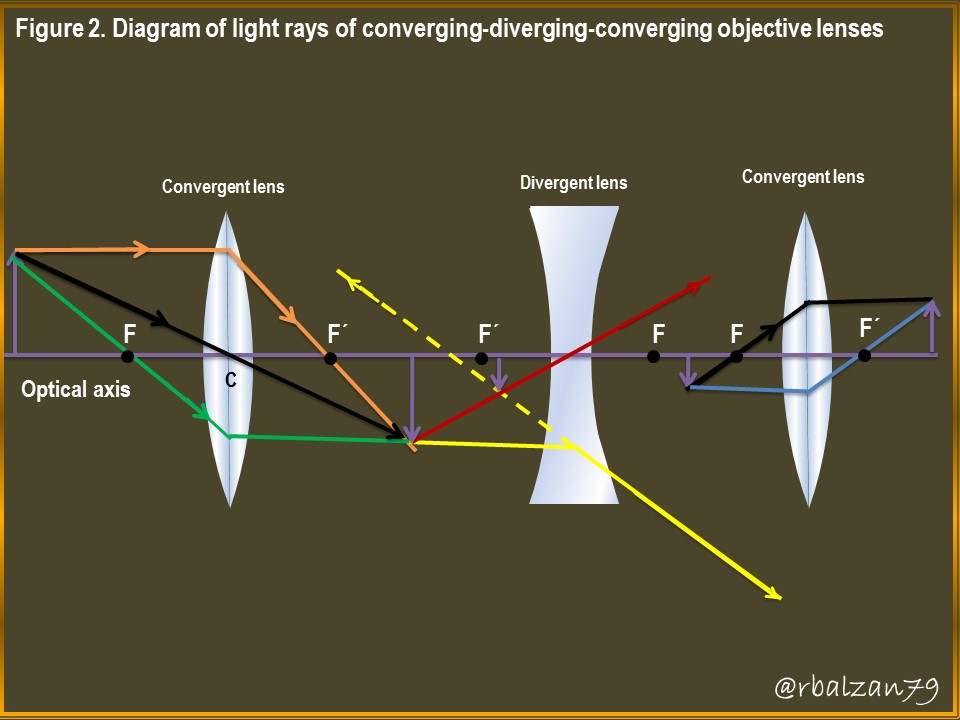
In the previous figure 2, you could notice the scheme of light rays in the three (3) lenses of the objective part of the analyzed optical instrument, in the first convergent lens we implemented three light rays, one parallel to the optical axis (orange), another one, The image generated is characteristic of this type of lens when the observed object is at a distance greater than the focal length, i.e. inverted image, on the other side of the lens and real.
When passing through the second lens, in this case, divergent, everything changes, since the image generated is right (not inverted) in relation to the position of the object that projects the rays to this lens, the image is virtual and originates from the same side of where the object is, in this way this image reaches our third lens, the convergent, where the image generated is real, inverted and on the other side of the lens and, this because the object is at a greater distance than the focal length of the lens.
Now, if we wanted to know the size of the image generated by our objective lenses (converging-diverging-converging), we would have the following data, a person observes a small tree whose height (Y) is 1.5 m, and the converging lens-object distance is 4 m (X), the image generated by the converging lens is projected at a distance of 10 cm (X') from the transmission side of the light rays refracted by the converging lens.
Therefore, the image generated in the converging lens is now observed by a diverging lens, but, now as the object, the height of the object will now be the value we calculate of Y', which originated at a distance of 10 cm from the diverging lens (X1), the distance of the second image generated by the diverging lens (X'1) is 3 cm from the diverging lens, so let's analyze our first two lenses as shown in Figure 3 below.
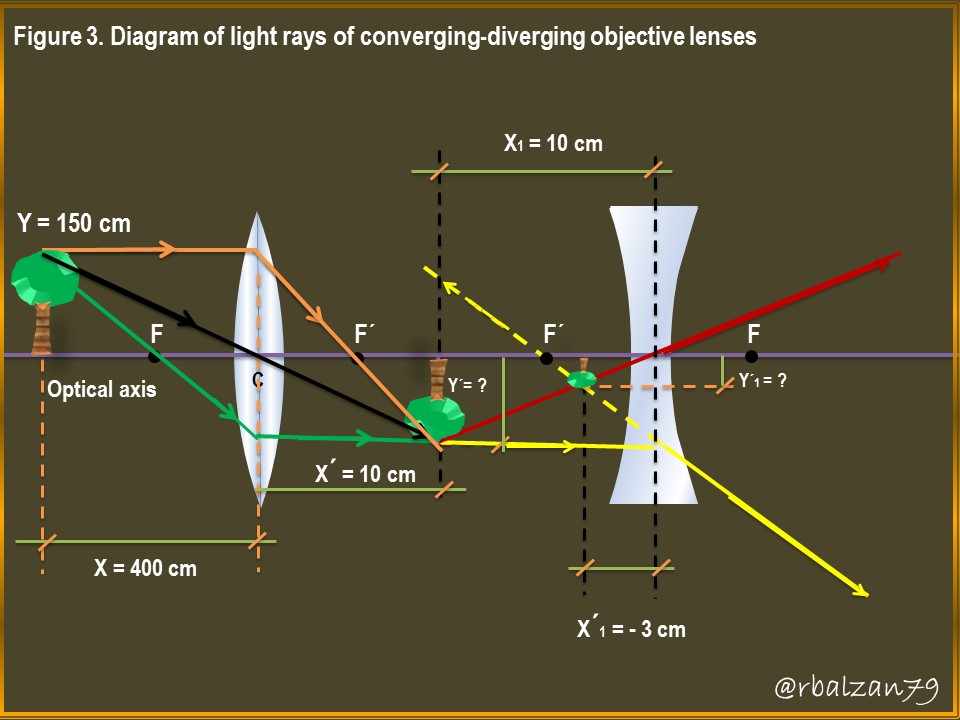
Data for convergent lens:
Y = 150 cm (Object height).
X = 400 cm (Object to lens distance).
X´= 10 cm (Distance of the image with respect to the converging lens).
Y´= ? (Image height).
Data for diverging lens:
Y1 = 3,75 cm (Size obtained from the image generated by the converging lens).
X1 = 10 cm (Object distance).
X´1= - 3 cm (Distance of the image with respect to the diverging lens, negative because it is formed on the incidence side of the light rays).
Y´1= ? (Height of the image generated by the diverging lens).
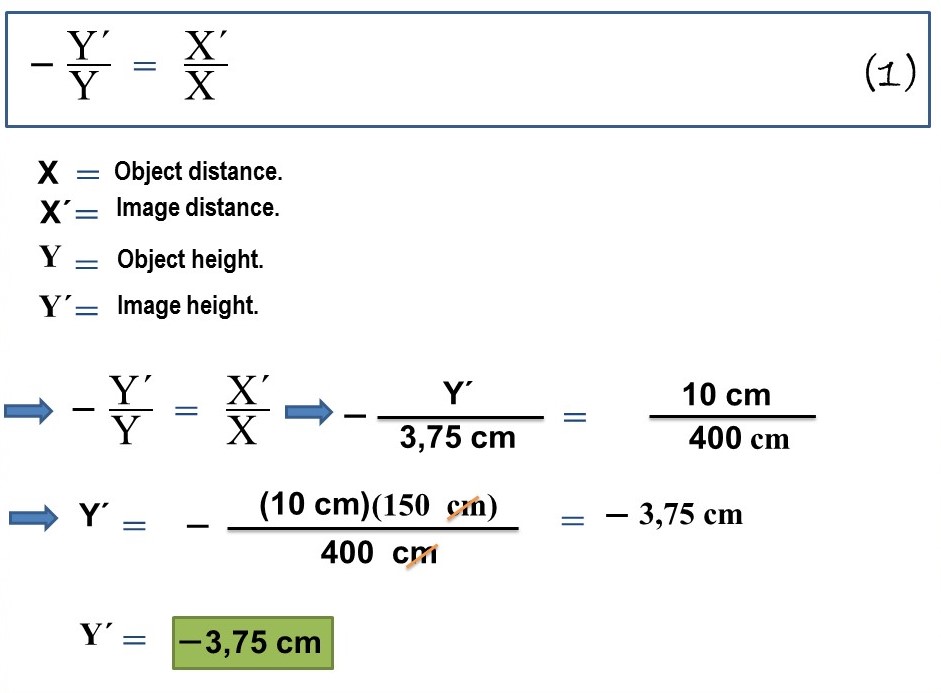
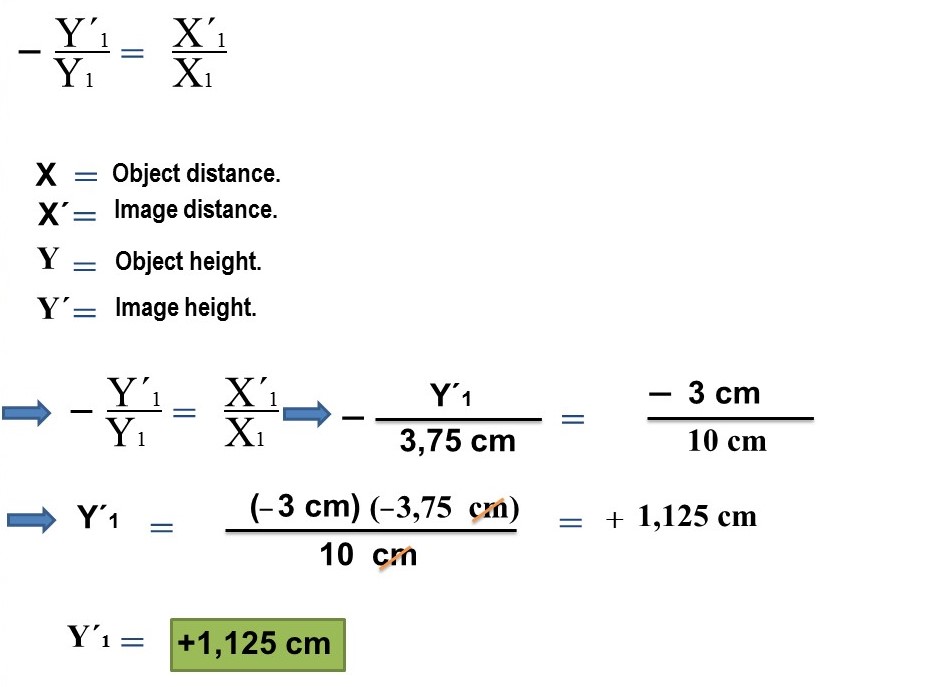
In this way we managed to obtain thanks to the formulation of the lenses, the size of the first two images generated by both the convergent lens and then by the divergent lens, both sizes were 3.75 and 1.125 cm respectively, with the latter size the image arrives at the next convergent lens, if this image now object, is located at a distance of 3 cm from the convergent lens and, upon impact of the light rays on the convergent lens would generate a real and inverted image, on the other side of the lens at a distance of 2.5 cm, with these values and the formulation 1, we can obtain the following value of the height of the image observed in the following figure 4.
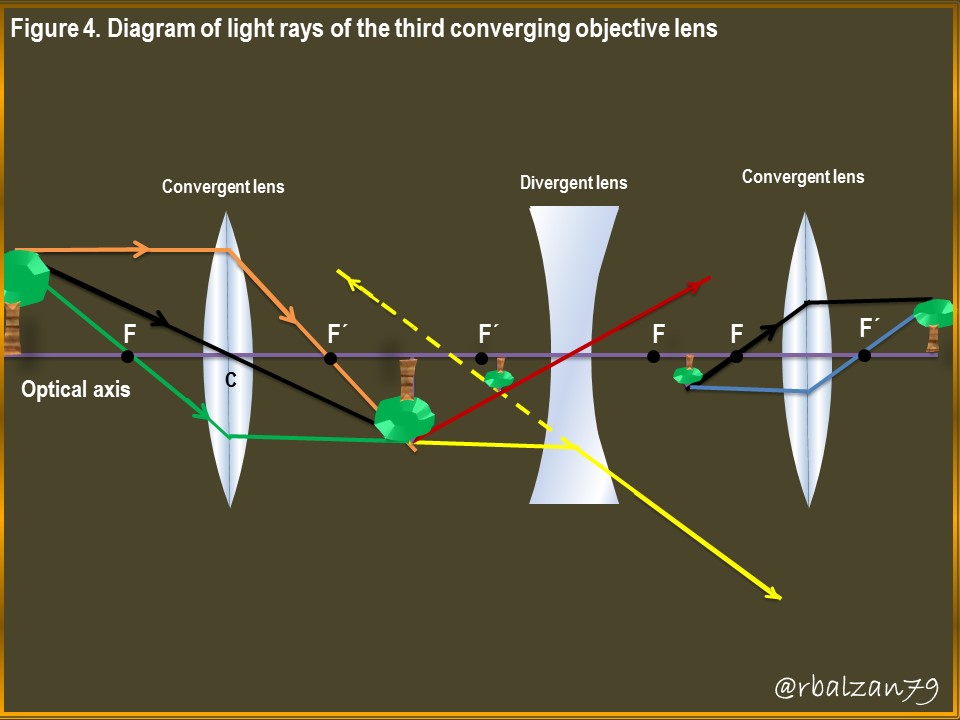
Third lens data (convergent):
Y2 = 1,125 cm (Object height).
X2 = 3 cm (Object to lens distance).
X´2= 2,5 cm (Distance of the image with respect to the converging lens).
Y´2= ? (Image height).

In this way we can calculate the height of the third image generated by the third component lens of the objective part of the optical device (reflex camera), from here the image will be projected onto the plane mirror which is inclined at 45°, in order to send the light rays and thus the image to the Pentaprism, but, before that, you can see the behavior of the image in a plane mirror in the following figure 5.
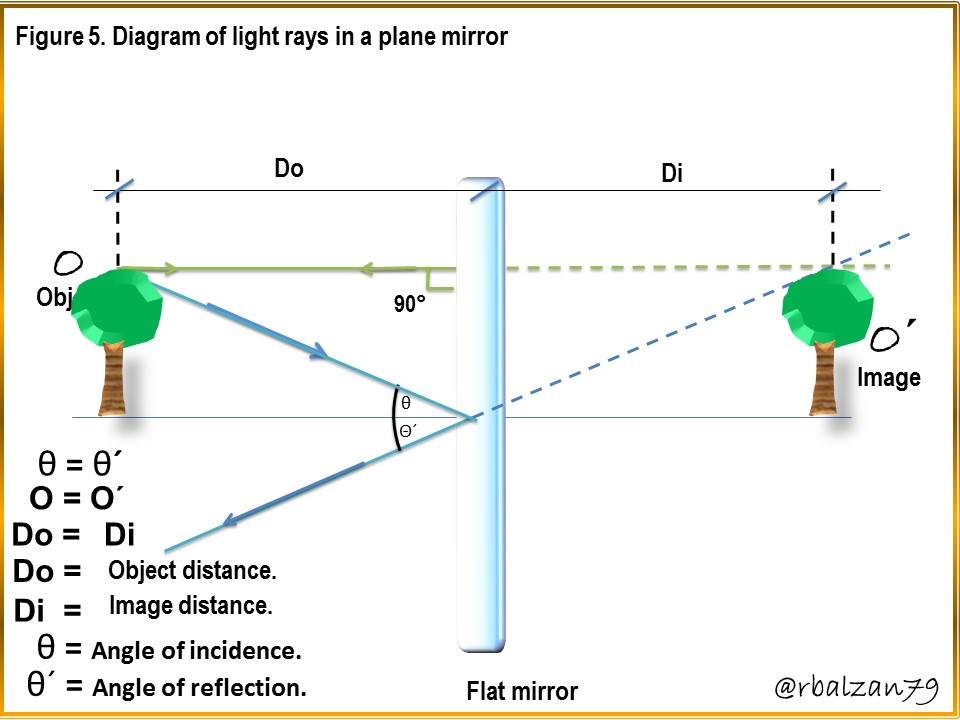
In the previous figure 5, we relate again with the optical element as the plane mirror, here the light rays will follow the law of reflection, therefore, the incident angles are equal to the reflected angles (θ = θ'), the image received by the plane mirror, is right, that is, with the same orientation as the object, it is always important to remember that the images in plane mirrors are generated by projecting each incident ray on the other side of the mirror.
The characteristics of the image generated by the plane mirror will be; virtual image, of the same size of the object and not inverted, then, the image will come out with the same characteristics with which it arrived from the convergent lens in this case already described previously and, with these characteristics it will arrive to the following optical element that in this case is the pentaprism, as you can see in the following figure 6.
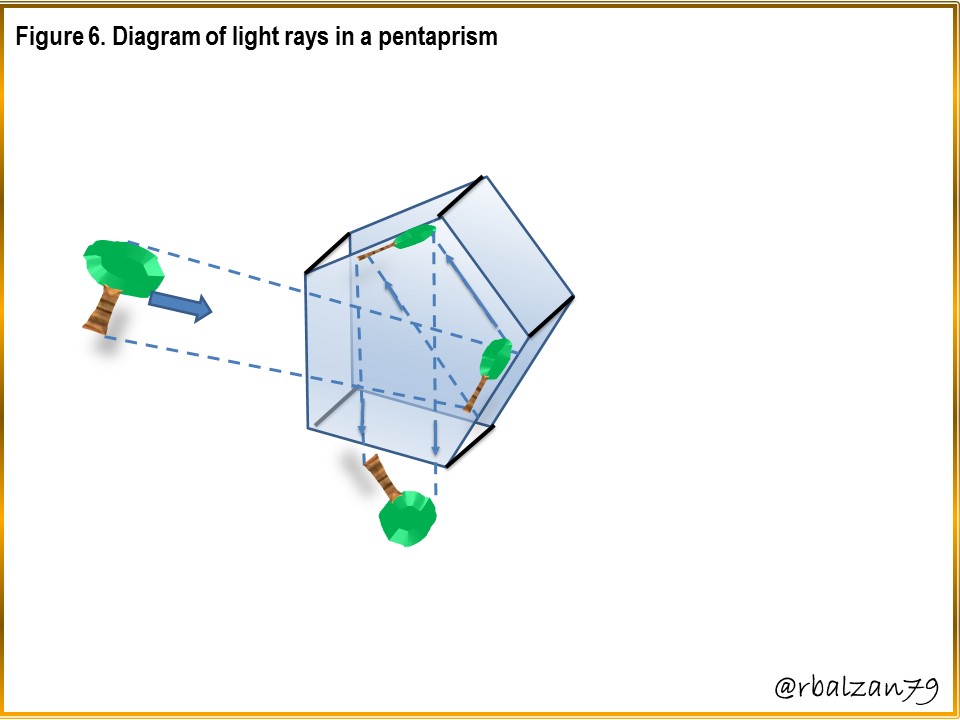
In the previous figure 6, we observed the behavior of the luminous rays in a reflective pentaprism, of this we can express that it is implemented to deflect the light rays that arrive inside it, as we observed in the previous figure 6, in this case the light ray is deflected twice, each deflection at 90°, that is, 180° from the position of the image-object that arrives at this optical element, therefore, it does not totally invert the received image, It is important to emphasize that in this type of optical element the reflection of the light rays does not occur due to a total internal reflection, but rather, the faces where the light rays strike are reversed and, with this, reflective surfaces such as mirrors are originated and, thus, reflect the light rays, now let us move on to the other optical elements located in the eyepiece of this instrument, as you can see in the following figure 7.

In this way, we managed to make the journey in terms of the generation of images in each of the optical elements of our reflex camera, equipped with converging and diverging lenses, pentaprism and, of course, a plane mirror, the image that reaches the retina of the person observing through this instrument is inverted and, therefore, the image is seen right when it reaches the brain.
Conclusion
Each optical component designed by man is of great value in the construction of any optical instrument, such as a reflex camera, which we analyze in a general way in this opportunity, in order to make a tour in the generation of images in each of these optical elements, until reaching the retina of the person who is ready to observe through this instrument.
In addition, we were able to perform some calculations related to the size of the first three images generated in the component lenses of the camera lens, the first convergent lens generated an image of size 3.5 cm, the minus sign is because the image was inverted during the development of the phenomenon of refraction of light rays, then this image becomes the object for the second lens, in this case divergent lens, this lens does not reverse the image hence the positive sign of the calculated value and, whose size of the virtual image turned out to be 1.125 cm.
Then in the other convergent lens the image is inverted again, hence the negative sign and, with a value for its size of 0.94 cm, all this according to the specified data, from there the image goes to the plane mirror, where the reflected image remains with the same orientation with which it arrived, then passing through the reflective pentaprism, providing a movement of the generated image of 180°, to then pass through the two convergent lenses located in the ocular part of this optical instrument, where the image manages to arrive in an inverted way to the retina of the person observing the small tree.
Until another opportunity my dear friends.
Note: The images were created by the author using Power Point and Paint, the animated gif using PhotoScape.
Recommended bibliographic references
[1] GEOMETRIC OPTICS. Link.
[2] Convergent lenses. Link.
[3] Images in Planemirrors. Link.
[4] Lens Basics. Link.
[5] Penta Prisms. Link.
Thanks for your contribution to the STEMsocial community. Feel free to join us on discord to get to know the rest of us!
Please consider delegating to the @stemsocial account (85% of the curation rewards are returned).
You may also include @stemsocial as a beneficiary of the rewards of this post to get a stronger support.
Thank you for your valuable support. Best regards.